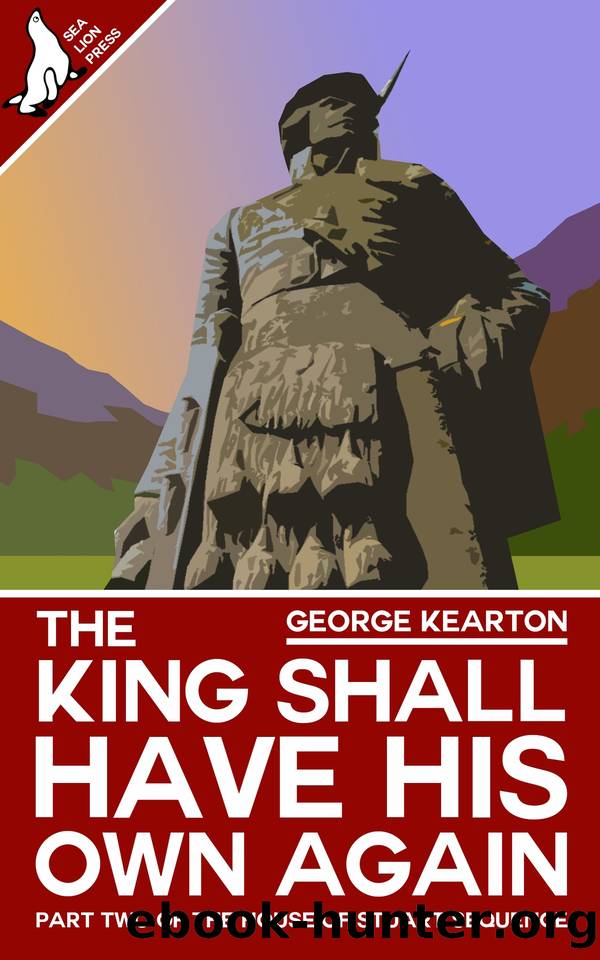The King Shall Have His Own Again by George Kearton

Author:George Kearton [Kearton, George]
Language: eng
Format: epub
Tags: RO:SF
Publisher: Sea Lion Press
Published: 2016-10-07T00:00:00+00:00
The last battle â Drumossie Moor, Saturday the 1st of May, 1751
On the 1st of May 1328 a treaty was signed in Northampton which brought to an end the First Scottish Wars of Independence. Under the treaty, England relinquished all claims to the throne of Scotland.
On the 1st of May 1707 the Act of Union was passed. It united Scotland and England as one kingdom and abolished Scotlandâs Parliament.
The Northampton treaty lasted only seven years before the English repudiated it and re-launched their attempts to conquer Scotland. The Act of Union was to stand for forty years before King James III restored Scotlandâs Parliament.
On the 1st of May 1751, two armies faced one another across the wild and windswept Drumossie Moor south of Inverness and north of Culloden House.
The larger of the two armies was made up of over 7,000 Scots; Protestant Episcopalians and Catholics, Highlanders and Lowlanders. They had assembled to defend their kingdom, their newly regained Parliament and the House of Stuart by driving out an invading army. The invaders were a 2,000 strong force of Hanoverian soldiers under the command of William, âDuke of Cumberlandâ and second son of George, the Elector of Hanover who had been forced off the throne of Great Britain by Prince Charles Stuart â who now, following his fatherâs assassination, was about to be crowned King of the three Stuart Realms.
Moving south from Inverness, the Stuart army took up a strong position which was bordered on either side by walled enclosures. To the left were the Culloden Parks which were occupied by the men of Glengarry and Keppoch. On the right there were two separate enclosures: the Culwhiniac was occupied by Clan Chattan, and a small party of MacDonells took post in the Leanach enclosure which, being further south than the Stuart front line, was a precarious post. For the MacDonells, this was a position of honour and possible redemption; a member of their clan, it was rumoured, had taken some part in the shooting of King James in Westminster Abbey.
The major part of the Stuart army, under the command of Sir John Roy Stuart, was anchored between these walled areas and was drawn up in traditional style clan by clan. In the centre was Stuartâs own Edinburgh Regiment and with them were a number of light artillery pieces mounted on carts and with crews from the naval squadron which, under letters of marque from the crown, had just captured the Hanoverian fleet of hired Dutch merchantmen outside Inverness harbour.
The invading army comprised some 2,000 professional Hanoverian and Hessian soldiers and was split into two battalions. The front line battalion was under the command of James Wolfe who had accompanied the Elector of Hanover into exile, and the second line battalion was commanded by General Henry Hawley who had successfully evacuated most of the British/Hanoverian army from Portsmouth in 1745.
Just over three miles away were a force of some 3,000 men of Clan Campbell. They had agreed to take part in the rebellion against the Stuarts but only if supported by a strong Hanoverian force.
Download
This site does not store any files on its server. We only index and link to content provided by other sites. Please contact the content providers to delete copyright contents if any and email us, we'll remove relevant links or contents immediately.
Sita - Warrior of Mithila (Book 2 of the Ram Chandra Series) by Amish(54761)
The Crystal Crypt by Dick Philip K(36821)
Cat's cradle by Kurt Vonnegut(15265)
Always and Forever, Lara Jean by Jenny Han(14854)
Ready Player One by Cline Ernest(14588)
The Last by Hanna Jameson(10198)
Year One by Nora Roberts(9746)
Persepolis Rising by James S. A. Corey(9298)
The remains of the day by Kazuo Ishiguro(8897)
Never let me go by Kazuo Ishiguro(8798)
Red Rising by Pierce Brown(8694)
Dark Space: The Second Trilogy (Books 4-6) (Dark Space Trilogies Book 2) by Jasper T. Scott(8147)
The handmaid's tale by Margaret Atwood(7712)
The Circle by Dave Eggers(7067)
Frank Herbert's Dune Saga Collection: Books 1 - 6 by Frank Herbert(7009)
The Testaments by Margaret Atwood(6840)
Legacy by Ellery Kane(6620)
Pandemic (The Extinction Files Book 1) by A.G. Riddle(6495)
Six Wakes by Mur Lafferty(6203)
